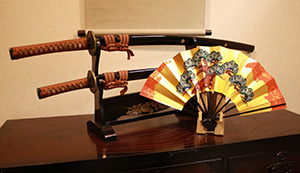-
Kabuki Theater and Kaomise

Kabuki is a popular traditional stage drama in Japan performed exclusively by men along with songs and music . Its history began in 1603 , when Okuni , a miko ( Shinto shrine maiden ) of Izumo Taisha Shrine started performing a new style of dance drama on the dry river beds of Kyoto . In Kyoto, there were seven Kabuki stages in the 17th century but only the Minami-za Theater remains to this day.
-
Kimono Show

The Nishijin Textile Center, located in Imadegawa, is a modern-style building where demonstrations and exhibits are held on the theme of the traditional Nishijin textile industry. In addition to a kimono show (7 times a day) are hand-weaving demonstrations and a display of historical materials. It is the perfect place to take in the beauty of gorgeous Nishijin textiles.
-
Miyako Odori

Starting with a call “YO-IYAa-SA-” as greetings, Geiko and Maiko come to the stage through two passageways. The audiences become still for a moment and start to give an exclamation of admiration… Miyako Odori is composed of eight scenes in total. It starts to depict a scene in spring, and then moves to scenes in summer, fall, winter, and spring for the finale, describing the season’s transiton in one-hour performance. The first scene “Prelude” as in the photo (upper) introduces the highlights of the following scenes. Our grand finale with 60 dancers is impressive and lavish.
-
Gion Corner

Gion Corner is a unique theater presenting one-hour shows of seven of Kyoto's professional performing arts - kyogen classical comedy, kyomai dance, gagaku music of the imperial court, koto harp, bunraku puppet theater, the tea ceremony, and flower arrangement. Visitors can also experience a genuine tea ceremony and learn about tea ceremony etiquette in a casual atmosphere. Since explanations of the performances are given in English, Gion Corner is popular among tourists from abroad.
-
GEAR

The performance GEAR got into the 3rd year in a long run. First of its kind in Japan, GEAR is a unique non-verbal performance that stimulates your five senses with a moving story set in the future. Accompanied by impressive stage effects set up using techniques ranging from those used in Kabuki plays to the latest technologies, GEAR is bound to offer you a theatrical experience you will never forget!
-
Samurai Kembu


Samurai kembu is the traditional performing art with a Japanese sword 'katana' and a Japanese fan. The word ‘kembu’ means literally ‘sword dance.’ In feudal times samurais danced with their swords and fans to give themselves courage or to achieve mental concentration. In the movie "The Last Samurai" you can see the actor performing Kembu on the day before the battle. Usually samurai kembu players perform to a background song and music. Chinese-style poems or Japanese short poems are used for background songs. Some songs express the bravery against enemies according to samurai beliefs and some songs air out the feelings of leaving ones hometown.
-
Japanese Head Spa

Japanese head spa, which is a uniquely Japanese skill, is recommended for treatment of eyestrain, stiff shoulder and thinning hair. It also helps to keep scalp and hair beautiful, lift up the face and activate the internal organs. You’ll get relief from daily stress and bad condition, and feel supremely deep relaxation & detox by stimulation to your scalp.
